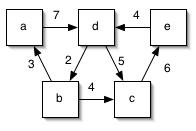Homework Assignment 6
General Algorithm Design Techniques
CS 3530
Design and Analysis of Algorithms
Spring Semester 2014
Due: Friday, May 2, at 5:00 PM
Notes
Problems 1 and 3 ask you to write code. Problems 2 and 4 are
pencil-and-paper exercises.
The programming problems are smaller than the ones we've done
on other homework assignments, but I'd still follow the basic
advice from
Homework 5:
Start small. Take small steps. It is okay to implement
something that is quick and dirty and guide it into something
that is cleaner and more efficient.
Tasks
- Implement the dynamic programming algorithm for
the World Series problem
as a function or object in a programming language of your
choice. Then use your code to compute P(3,5) when p
= 0.25. (Note that Team 2 needs to win five games yet, so
this must be at least a nine-game series.)
Extra credit. Make it so that not only the size of
the grid and the value of p can be passed in, but also
the rules for filling in the grid. Demonstrate that your
extension works on an example of your own choice.
- Show that the dynamic programming approach to the Knapsack
Problem, described in
Session 28
and its assigned reading, is O(nW) in time. You may
find it helpful to sketch the algorithm in greater detail
first.
- Consider this scheduling problem... We have a single
processor on which to run n jobs of lengths
t1, t2,
... tn. We can execute the jobs
in any order we like. We want a schedule that minimizes
total time spent in the system by all jobs. The time spent
in the system by job k is the time it spends waiting
to start plus the time it spends running.
One greedy approach to solving this problem is to execute
the longest jobs first and the shortest jobs last. We'd like
to know how well this approach performs in practice. So...
Implement this approach as a function or object in a
programming language of your choice. Demonstrate its
performance on at least ten random inputs where n
≥ 100. Show the results in a table.
Extra credit. Write a formal proof that the greedy
approach is or is not optimal. You may want to consider some
examples for small values of n and generalize what
you learn from them.
- Use Dijkstra's Algorithm from
Session 29,
to find the shortest paths from vertex c to
all other vertices in the following graph:

Create a readme.txt file that presents:
- anything I need to know to compile and run your
programs for Problems 1 and 3
- a table summarizing the results of your experiments
for each
Deliverables
By the due time and date, submit
- a zipped archive named homework06
containing:
- your readme.txt file
- all of your source files
- hardcopy of your readme.txt and solutions to
Problems 2 and 4
Be sure that your submission follows all
homework submission requirements.
Eugene Wallingford .....
wallingf@cs.uni.edu .....
April 24, 2014
